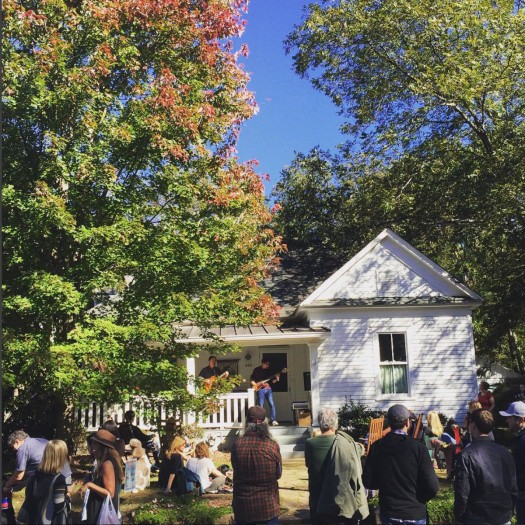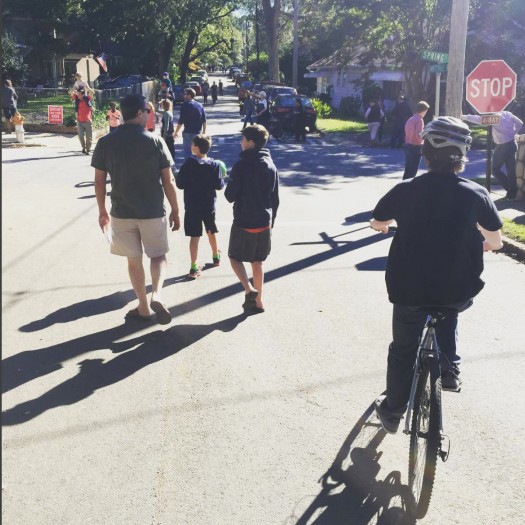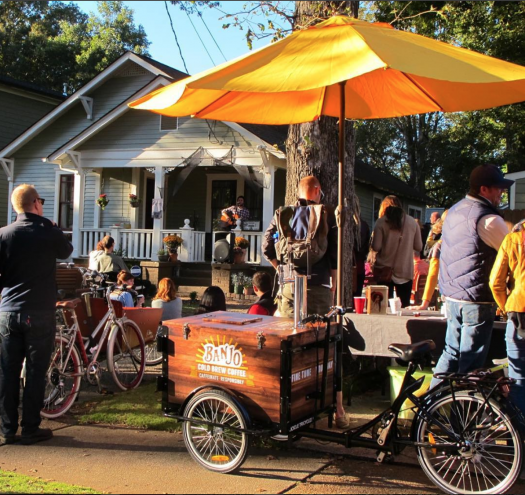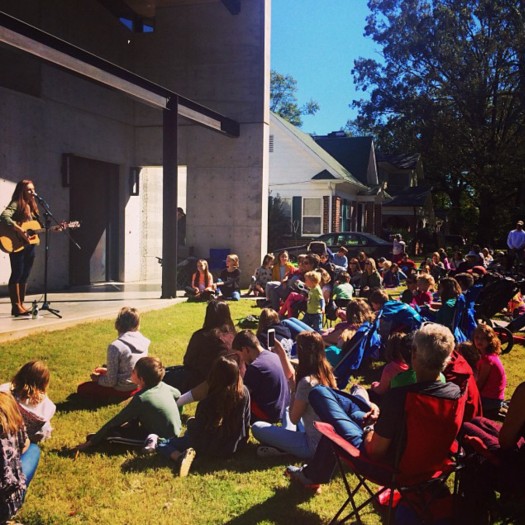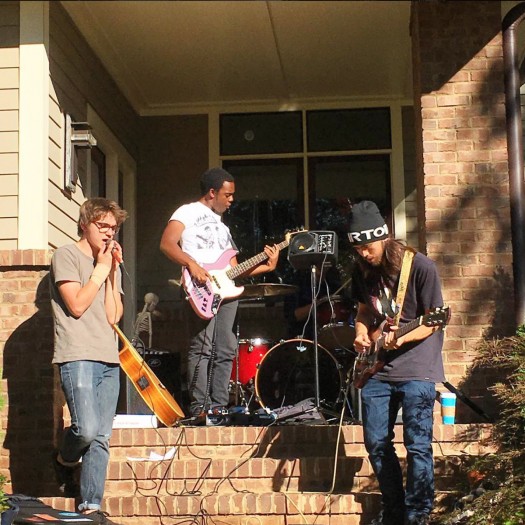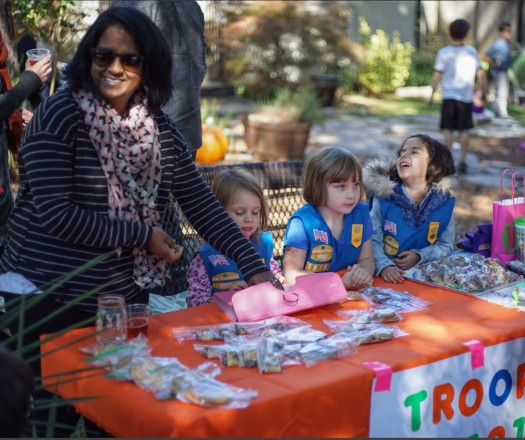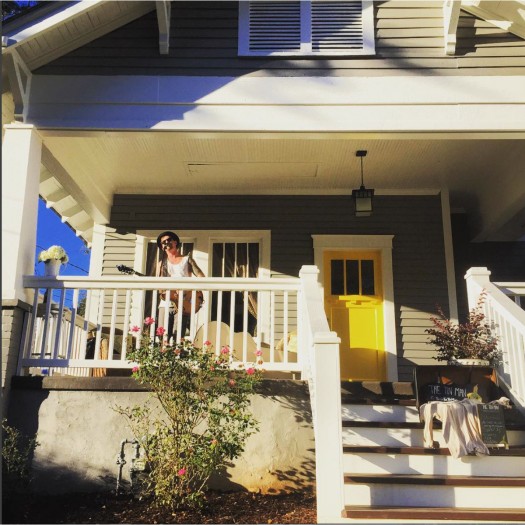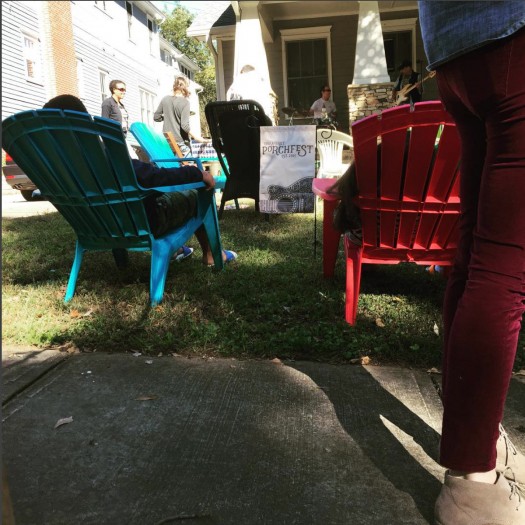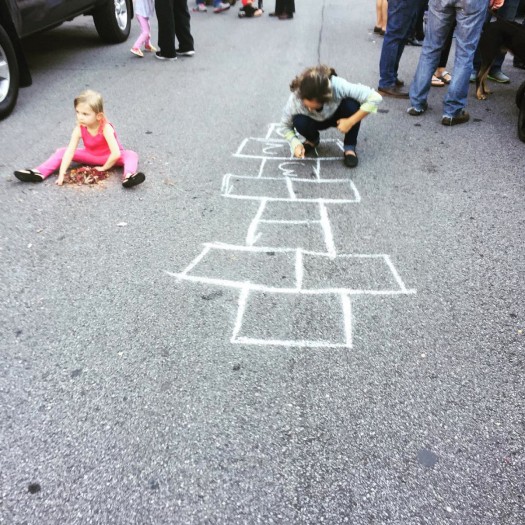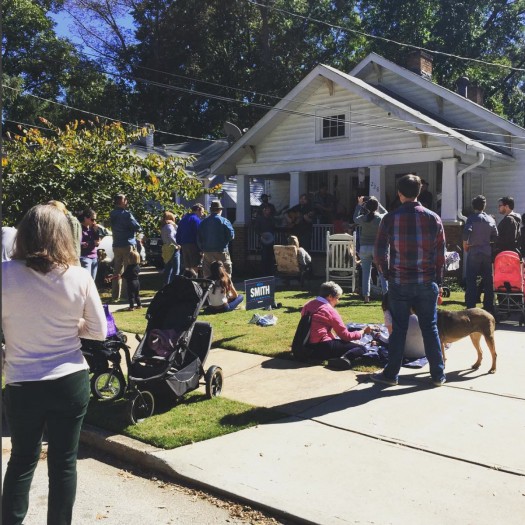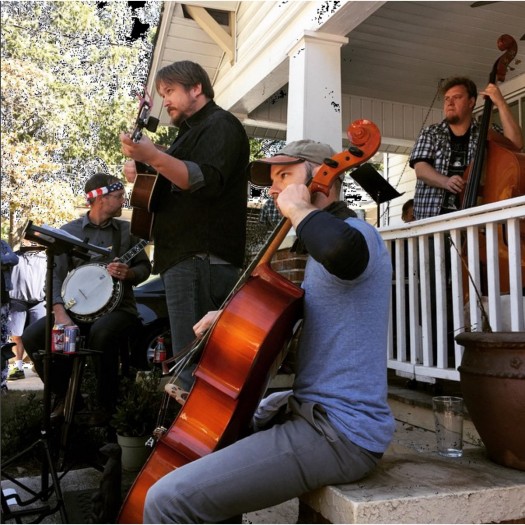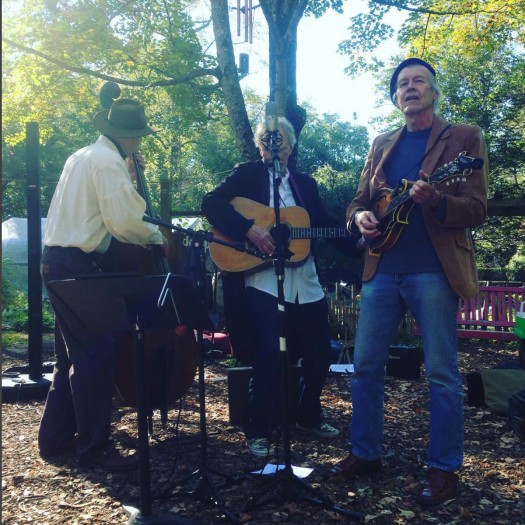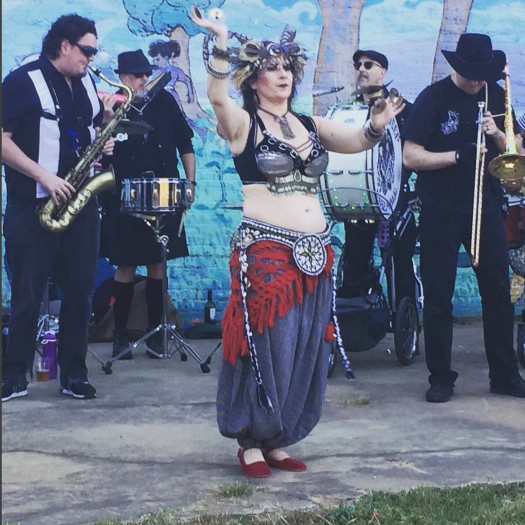A Placemaking Journal
Porchfest: Your Guide to a DIY Community-Building Good Time
Five or so years ago, Better Cities and Towns publisher Rob Steuteville told me about Porchfest, a yearly community event taking root in his Ithaca, New York, neighborhood. The idea is simple: For one afternoon, porches throughout the community become makeshift stages, yards become venues, and people from within and beyond wander the streets, chatting, taking in music, and basically reacquainting themselves with what it means to be neighbors.
It’s grass roots, open to all, and totally free.
It was an idea ripe for emulation and I had the perfect idea where: My own, porch-laden neighborhood in Decatur, Georgia. So I added it to my list of things I need to get right on, then promptly neglected it for the next five years.
Thankfully, over the course of those years, a lot of other communities had similar inclinations — and better follow-through. Now, there are upwards of 40 Porchfests across the continent and the list keeps growing.
All in this together
From a vocational perspective, I’ve written before (here, here and here, for example) on the connection between neighborly interdependence and community resilience. In short, I don’t believe the downsides of our present urban renaissance (issues of displacement chief among them) can be equitably addressed without a meaningful underlying web of community connection from which to operate.
Such connection doesn’t just fuel neighbor-to-neighbor compassion in times of immediate need (no small thing, in and of itself); it also fosters coordinated political strength in driving policy changes at the municipal level — targeted tax relief, zoning reform, affordable housing, or demolition moratoriums, to name some relevant examples. People who know each other are more inclined to care about each other, and people who care about each other are more inclined to advocate on one another’s behalf — or, at the very least, not dig in their heels quite so vigorously in the service of self-interest.
That’s what hooked me on the Porchfest idea. My neighborhood of 20 years, like many sought-after in-town areas, is presently experiencing a number of these sorts of challenges and, quite frankly, I don’t see a disconnected, fractured or adversarial community particularly well positioned to do much about them.
We, like every community, need to foster a broader sense of cohesion and shared interest if we want to remain, in spirit, the same community that has attracted or kept us here. That’s a big part of why this finally became the year we set out to make Porchfest happen for us — to effect some small degree of incremental improvement in that regard.
Here’s what I wrote this past August after we locked in and kicked off our efforts to get it going:
Will this prove to be an event that draws people out? That encourages them to park their preconceptions and meet their neighbors on common ground? To pursue connection, despite differences in household income or politics or even race? Will we forge ties that can be leveraged later, in good times or bad?
I don’t know. But I do know this: Given the choice between doing something and doing nothing, I’ll take the former. If even a handful of people come away feeling friendlier, better connected, or more empathetic toward others’ circumstances, it’ll be a success. And that’s a start.
Now that the event — christened the Oakhurst Porchfest — is over, I can take stock of how well it played out. Which was well. Quite well. Attendees numbered in the many hundreds, if not thousands. Social media exploded. Craig Rafuse, a part of the community for 30 years, was so moved by the re-emergence of a spirit he’d found lacking in recent years that he felt compelled to shoot me his storied, three page reflections on the event.
“Deep roots of communion and community like these, in and among our adjacent abodes, are, I’m sure, everywhere,” he said. “The groundswell of enthusiasm here for Oakhurst Porchfest, connected through social media as well as word of mouth, casts a glorious example.”
Another neighbor, Brian Kammer, was equally moved. “What I loved about this year’s Porchfest is the vision of community it created,” he wrote. “It was a vision of a peaceable world, a neighborly world. A place free, for the time being, of recrimination and acrimony. The community worked hard to make this happen, to create this seemingly effortless day of public celebration. It made the community stronger because neighbors got to know each other as people. As the day went on, the thought kept recurring to me: this is what peacetime looks like, we need to spread this around! And: we can lose this if we’re not vigilant, especially in these times. We’ve got to cherish these moments and make more of them if we are going to make it through the coming years peaceably.”
Similar sentiments abounded as long-term residents — rich in the perspective that comes from one’s first-hand experience of neighborhood history — celebrated a newfound sense of shared destiny with relative newcomers drawn in recent years.
Lessons learned
Maybe some of the things we learned doing this can be of aid to other communities considering their own take on Porchfest. If so, here you go:
Choose the right bedfellows
The effort really needs to begin in the neighborhood but, in our experience, it needs the right partners to fully succeed. For us, that included a media partner (a well read local news blog) and the local arts nonprofit, who’s particularly skilled in navigating municipal logistics, making for a lean and responsive team of three. Beyond that, you probably don’t need it.
Be careful what you wish for
When we committed to taking this on, we considered the prospect of what would constitute success. From what we’d read, Ithaca’s first year featured roughly 25 performances so, with that as a benchmark, we decided that we’d be thrilled with anything over 30.
Clearly we miscalculated the pent-up demand for this type of event. Fueled by some very generous advance coverage from our local NPR station, we’d amassed 134 performers (some bands, some solo) and 130 porches on which to host them by the time we shut down registration a month later.
Reframe the intent
In most communities, people think of festivals as something being done for them. But Porchfests, by virtue of their grass-roots, crowd-sourced nature, are orchestrated by them. This can’t be repeated often enough because it’s ultimately the broad sense of shared ownership and personal emotional stakes in success that make the event thrive.
For us, this resulted in all kinds of inquiries from residents wanting to contribute. One of our founding principles for the event was, to whatever degree possible, we don’t spend money and we don’t make money. Instead, we remain an event rooted in giving for giving’s sake. And that paid off, so to speak. One resident took the lead in creating yard flags, produced them herself and sold them at cost to recoup her outlay. Another, with a promotional items company, paid to create event drink koozies, then distributed them willy-nilly for free. We even had a professional video editor ask if she could shoot the event and compile a promotional video gratis. It was an offer readily accepted.
Don’t ask permission
I don’t mean this subversively. What I mean is that if this represents something entirely new to the community and you want everyone to ultimately take a sense of ownership then it shouldn’t begin by immediately subjecting itself to a status quo, top-down process geared towards a very specific type of event. True innovation tends to come more efficiently from outside conventional systems.
In our case we decided that, from a definition standpoint, we were less festival organizers and more scheduling coordinators of what turned out to be roughly 130 relatively simultaneous yard parties. Audiences congregate and musicians perform largely on private property, negating any need for traditional permits, blanket insurance coverage, etc.
Think differently about police
We had a great experience with our local police force who requested only that we keep them up to date on what we were expecting and that we provide them a map so they’d know where the action was. In response, they had a handful of officers floating around our one square mile event area, though we ultimately had no incidents.
The real beauty of the Porchfest model is that orchestration of the event is downloaded to every participating porch host which, in our case, made for 130 separate addresses with a stake in everything going smoothly. It was like having 130 or more on-the-ground deputies, each helping to maintain order in their general area. Taken collectively, it was infinitely greater than what you might accomplish via paid security.
Diversity rules
The most compelling thing about Porchfest is just how much musical variety can be experienced in a single afternoon and, from a genre perspective, we did well. So well, in fact, that Georgia Music, the tuneful wing of our state’s tourism bureau, asserted we were “very likely the most diverse musical lineup of any festival in Georgia.” Which ain’t bad.
But that diversity didn’t translate ethnically as well as we had hoped. We pulled our event together very, very quickly which didn’t leave time for targeted outreach to specific performers or styles which, by extension, surely had an impact on who did or didn’t attend. That’s something we plan to explore more diligently next year. One of the Porchfests we held as a model was the Jamaica Plains neighborhood in Boston who’ve managed to amass an ethnically varied line-up during their two years. By all accounts, they’re stronger for it.
Share the streets
We really didn’t know what to expect in terms of traffic or exactly where or how people might congregate going into the event but what ended up happening, while counter intuitive to some, was quite instructive.
In certain areas of the neighborhood, during certain times, we had some good sized crowds spilling out into the street. We also had a lot of people liberally using those streets to bike and walk between performances. From a conventional traffic management perspective, where streets are considered solely as conduits for cars, this sounds like a problem. But in practice it played out instead via countless expressions of mutual respect. Drivers slowed down, way down, or avoided certain streets altogether. And with such limited speeds, our streets ended up safer than I’ve seen them in the many years I’ve lived here. That wouldn’t have happened with a strict, stick-to-the-sidewalk mandate. Quite the opposite, actually.
In closing
For anyone here considering a similar endeavor where you live, I hope this provides some helpful ways to get started. But I’m now well over a thousand words in so whatever thousands are still needed I’ll include as pictures instead. Get a sense for the day below and don’t be a stranger.
–Scott Doyon
 If PlaceShakers is our soapbox, our Facebook page is where we step down, grab a drink and enjoy a little conversation. Looking for a heads-up on the latest community-building news and perspective from around the web? Click through and “Like” us and we’ll keep you in the loop.
If PlaceShakers is our soapbox, our Facebook page is where we step down, grab a drink and enjoy a little conversation. Looking for a heads-up on the latest community-building news and perspective from around the web? Click through and “Like” us and we’ll keep you in the loop.









